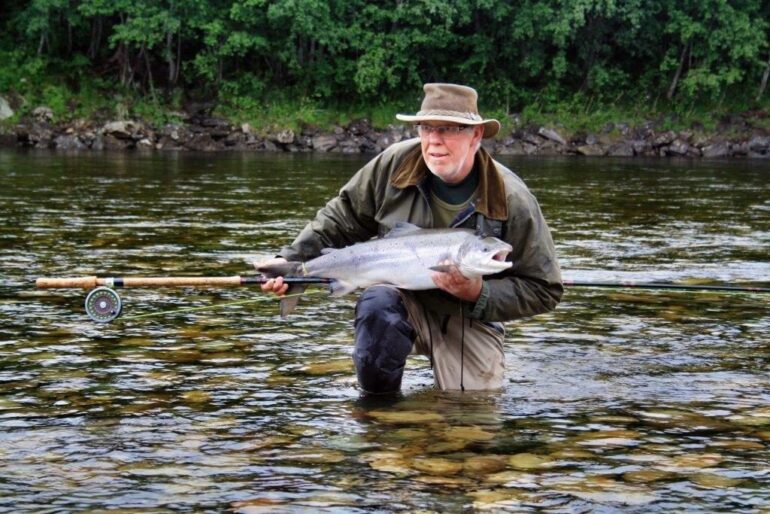
Comments from Across the Sea – Part 1
An article by Lars Mehl.
Introduction
 I’m from Denmark and in total, I have been fishing now for more than 50 years. I have taken the usual breaks from fishing caused by the study, military service, periods of general education and also having a family.
I’m from Denmark and in total, I have been fishing now for more than 50 years. I have taken the usual breaks from fishing caused by the study, military service, periods of general education and also having a family.
I still feel that my ongoing education as a fly fisherman is the one that has challenged me most during the previous years and it continues to still do so as I develop my understanding. The most challenging of all the disciplines of fishing is one of fishing for salmon. This I have done constantly for the last 15 years plus.
Living on the isle of Fyn on the Danish coast, (and presently the best sea trout coastal fishing venue in Europe also described as a paradise by many.)
I started fishing the coastlines during my youth, mainly with spoon and spinner in addition to fly-fishing. Most of my fly-fishing was with the dry fly after brown trout and grayling in the smaller streams on the mainland of Jutland (Jylland)
My attention was drawn to salmon and started during 1960-61 to fish for these incredible King’s of the river. I tended to fish the fast running bigger rivers at Skjern Å.
Opening of the season for me was 1st of April, but due to very low runs of salmon in Denmark, (salmon were almost extinct due to agriculture and pollution), I delayed and decided that Norway was a better venue. My first trip was at the age of 16 years.
My basic education in fly-fishing was a one week course each season at a fishing school for 3 years consecutive years arranged by the Danish Angler Association. Here we were educated in casting, entomology, fly tying and fish species identification.
The 3 years covered basic fly fishing knowledge were we were targeting Trout and Grayling the first two years followed by the Sea-trout fishing in the last year.
During the last 5 to 6 years on the riverbank in Norway, I have developed my interest in salmon fishing on the River Gaula. Each season I would spend 4-5 weeks starting on 1st. June and spread over the season, which ends on 1st September. During this time I have radically changed my approach and the way I conduct my fly fishing.
Salmon runs in Norway are also under pressure caused by such issues as aquafarming, deceases and problems with sea lice. This has been reduced due to the amount of salmon permitted to be killed and an introduction to the practice of Catch and Release. Regulations dictate how many fish can be harvested and at what length, sex etc. These restrictions change during the season including June / July-August.
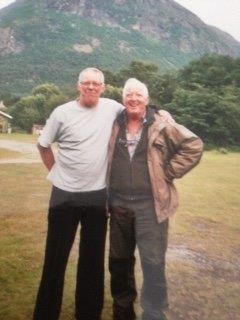
Personally, I am not in favour of Catch and Release, but I do respect the ones that practice this and that´s the reason I have adjusted my approach to my Salmon fishing or as I prefer lifted it to a new level.
I have been blessed to have met an old Swedish salmon fisher 20 years ago whom I have used as a mentor during my learning process. He never gives me a straight answer to my questions and makes me think about alternative approaches that I could consider to catching the fish.
He does have a lifetime of experience and carries a very strong reputation as a fisher and fly tier.
I will use the expression I have read somewhere else: “He has taught me everything I know about salmon fishing, but I would have loved it if I had been taught everything he knows about salmon fishing “
He is one of those who just come to the beat where others struggled for hours without contact. He will tackle up and start to fish. If he does not have any contact within an hour he leaves, which happens very seldom. On the other hand, he will take time with me when I explain what my experience has been and he will underline why I have not been successful compared to his own experience.
The Tackle I Prefer to Use
The tackle I use reflects today my background as an educated toolmaker. I also have an education in bamboo rod building that I learned as junior in the local fishing club.
My love for crafts is reflected in my tackle and I am a member of “Tackle Collectors club in Denmark” the oldest in Europe.
Reels
Rod in hand Bruce and Walker a Hoergaard reel with a Rio mid-Spey line
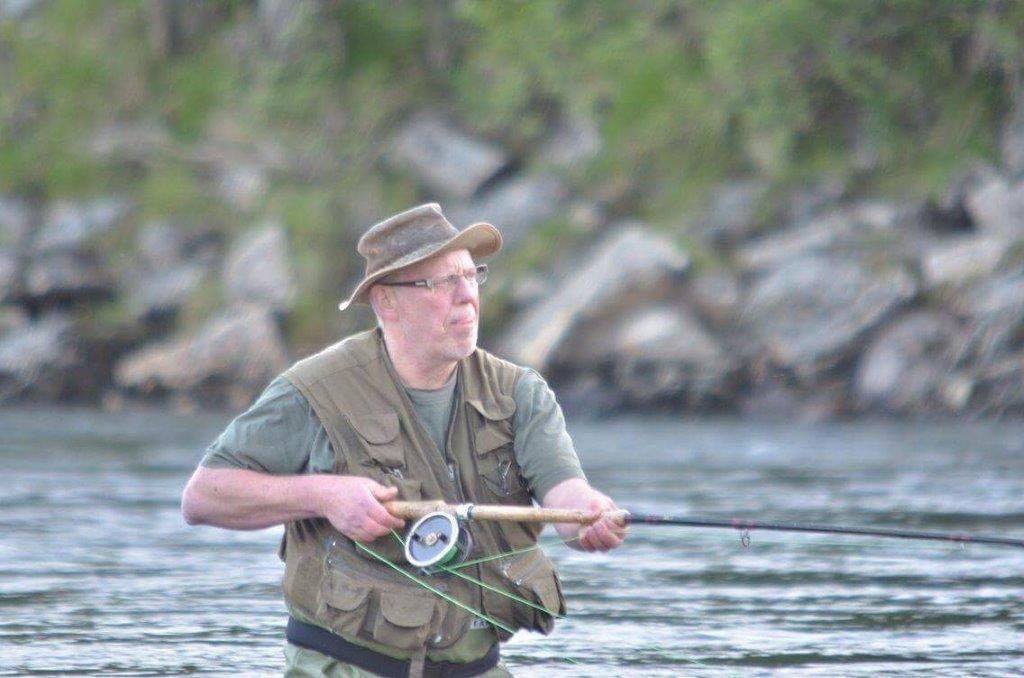 I practice Spey casting with full Spey and Double Tapered lines that are mostly floating. Occasionally I will use a sink tip, but in the main, it will be with a floating line in combination with a sinking leader.
I practice Spey casting with full Spey and Double Tapered lines that are mostly floating. Occasionally I will use a sink tip, but in the main, it will be with a floating line in combination with a sinking leader.
When conditions allow I will use silk lines in combination with the bamboo rods.
My rods are a Bruce and Walker Hexagraph, a Hardy Graphite and a variety of bamboo rods mainly used from mid-water level during summer fishing.
The length of the rod varies from 15” up to 20” for the Hardy rods.
The flies I use are single hook from 4/0 down to 4 as well as low water types from 2/0 down to 2.
I tie all my flies on Partridge 10/1, 10/2 or M as well as Mustad iron and prefer a feather dressed wing 80% in favour of hair 20 % and occasionally full dressed.
The difference in weight of the hooks allows me to choose a fly that will fish effectively for the specific fishing situation I face.
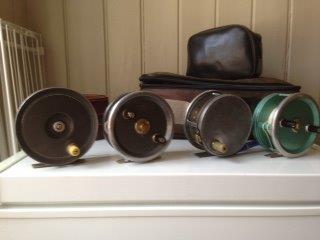 It may cross your mind that I take a conservative approach and yes I would agree, but on the other hand, you could ask yourselves the question: Do the Salmon give any points or care about the equipment or for that matter the fly you are presenting?
It may cross your mind that I take a conservative approach and yes I would agree, but on the other hand, you could ask yourselves the question: Do the Salmon give any points or care about the equipment or for that matter the fly you are presenting?
My answer is no! One only gets credit if it is used in the right way and the fly is presented and fished correctly.
For me, line control and the influence this has on fly presentation and speed of fly is what is most important.
Background research and experience:
The background research started more than 7 years ago and has developed slowly.
For years I have filled up my fly box with any known fly pattern and fished like the majority of anglers. I have fish for hours and with no contact. I have changed the fly, the leader etc. and fish on –eventually sometimes with success.
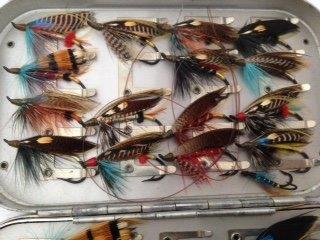 I still remember fishing a beat where one particularly pool was a good holding pool, throughout the season.
I still remember fishing a beat where one particularly pool was a good holding pool, throughout the season.
On my first visit in the afternoon that year there were already two fishermen fishing the beat. They were known as the “evening shift” as they were fishing the beat hard and had so each day from the 15th June until 21st August. They have done this for the last 10 years or more.
I talked with them in the hut and they informed me that they had not had any contacts for the last 6 days and everything was bad. They were known to be pretty tough salmon fishers. I decided to phone my mentor who I knew was fishing on another river. He had previously tied for me 3 patterns in 2 hook sizes for me.
I gave him the details of the current conditions he needed to know and he advised me on fly selection and how to use it – I tied on his recommended fly and on the fourth cast a salmon on 4.5 kg was hooked and landed. What were the conditions and what advice did your mentor give you?
On the enclosed photo, I have marked the 3 taking areas, this one was area 1.
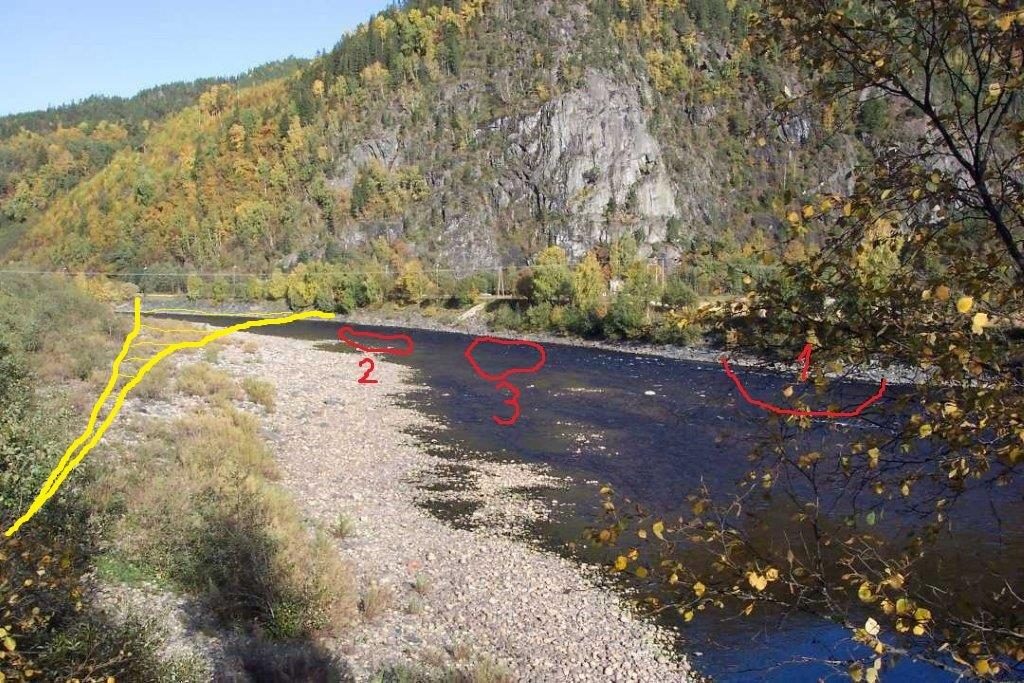
The water level was that day around a foot higher – and the secret of fishing that pools at that time was.
Watercolour condition this was clear water.
The weather condition was clear blue sky and position of the sun exactly into my back of the photo.
The response from the two experienced fisher sitting in the hut told me everything, they came running down the riverbank over the stones, it sounded just like being in a quarry.
They came down to look at the successful fly, which they recognised – and returned with the comment “strange fly pattern” for the day.
They subsequently changed their own flies to one similar to mine but had no success.
What was the reason for my success?
If you turn round and look behind there is a mountain (peak) and as the sun passes this it will create a movable shadow moving from the lower part of the pool and upwards.
It will never manage to shadow the whole pool –but I will create a shadow pattern performing a pattern shown with a yellow mark on the photo. As it moves upwards it changing is the shape and the whole scenery take app 20 minutes and the pool is back in the sunlight.
The take of the first salmon (no1) was close to the opposite bank just ahead of the frontline from the shadow.
The fly was a Black Doctor and it was cast upstream with an upstream mend to allow the fly to flow and position as close as possible toward the other bank before the final small downstream mend allowed the fly to swim close to the expected position of the salmon.
I went home and reflected and started to evaluate what had happened, while they changed fly and fished 6 hours more without any contact. Why had I been successful?
The year after I visited the same pool beginning August and only one fisher was sitting in the hut very depressed.
He had fished the beat and this pool regularly for the past 8 years, but the last 6 days he had not had any contact in the pool.
Due to my experience from the year before I studied the water and weather conditions and tied the proper fly on.
As I was ready he invited me to start fishing, it was his time, but he has been there for 6 hours without contact so I could just go down and try.
Half down on my first attempt, I hooked a salmon but the hook was shaken loose after 10 minutes.
Up in the hut I decided to change the fly, and as it was my turn to fish again I started to fish. I again hooked a new salmon 30 meter up steam from where the earlier fish had taken but once again the same result, and the fish was lost after 5 minutes.
I then decided to go home and once again reflected on these experiences. I revisited the water over a couple of days without any fishing studying the water and weather conditions on each visit.
I wanted to test out the possible importance of the shadow moving over the pool and test if my hypothesis on salmon behaviour was right.
- Salmon may move in combination with quick changes in light.
- Salmon staying in the deeper part of a pool will move due to light changes.
- Do salmon move in the same manner with different lays- and where should you concentrate your energy to fish them?
The fly selected was Blue Charm followed by a complete contrast a Black Muddler.
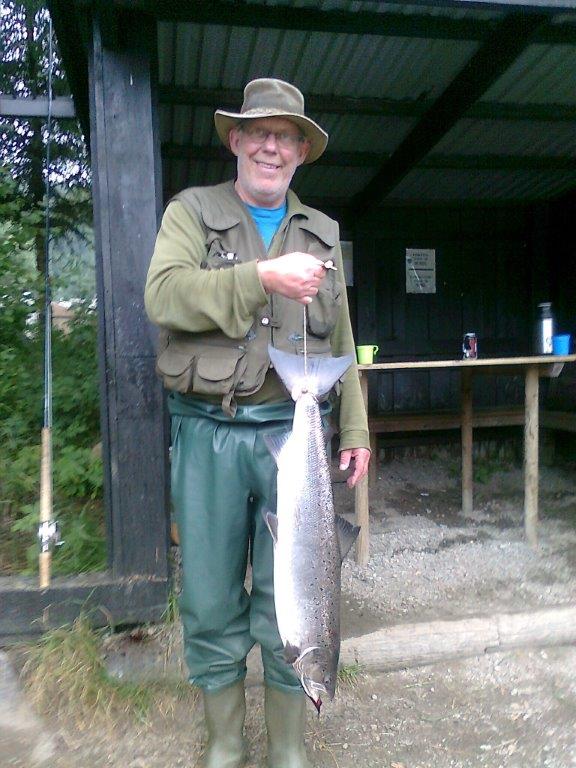
Based on the experience from the year before and that year where both salmon were hooked as the fly was fished in the almost same manner but with much more mending upstream allowing the fly to go deeper and after entering into the water covered by the shadow I mended downstream to activate and speed up the fly allowing it to fish/swim across the shadow water, and both takes took place inside the shadow part, opposite to the year before.
During that winter I had a lot of contact with my mentor and I asked him if he for the next season could tie me a specific fly with fixed size and colours for that particular pool to be tested the coming season.
On the photo, you find a variety the test flies was tied in. As I have given some away they collection are not complete.
They were tied in two main groups one with wing and one without.
The wing for this group was similar on all flies in colour and feather type.
The tail, body and body hackle was similar on both groups.
The front hackles were changed for the variety.
The fly was tested for a 2 weeks period on the same beat 2 A and 2 B as follows
Each fly was used for 2 hours.
Fly one used on day one in accordance with scheme from 06-08.00 was automatically used the second day from 08.00-10.00 and day 3 from 10.00-12.00.
 If I did not fish during a certain time the scheme informed me which one to tackle up when I started again.
If I did not fish during a certain time the scheme informed me which one to tackle up when I started again.
All flies were fished 20 hours or more.
Unfortunately, the price for license exploded on this beat so I changed to fish another beat 2km upstream managed by the local association (Støren Jæger og Fiske) on who’s beats I have fished ever since.
As I started fishing on this new beat, I have to study and learn how to fish that beat. It was well-timed in relation to the test fishing of the new fly that my mentor had produced for me.
The new beat does have holding pools as well, but not similar in layout as the previous one in respect to depth.
I then had to find the part of the river where the direction of the flow was similar geographically and study the water to pick out the possible holding spots for the salmon.
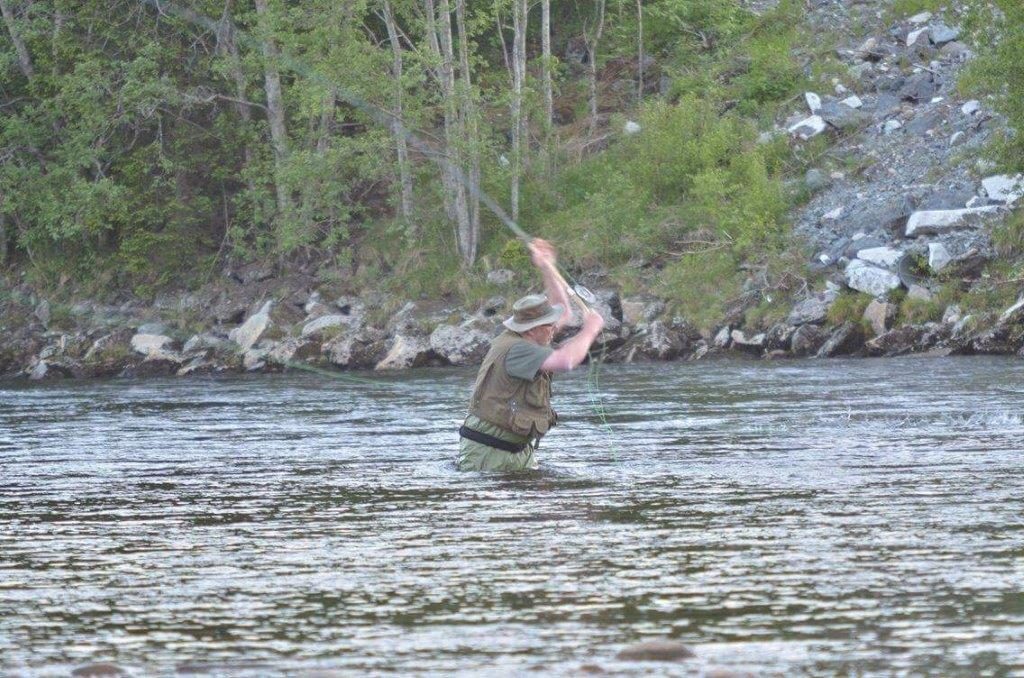 After 8 days’ of testing, I eventually hooked a salmon at 18.30 but after 20 minutes of tough fight the Salmon decided to give me back my fly and continue its journey, and I went to moisture my throat with a whiskey and made a note on all fishing conditions.
After 8 days’ of testing, I eventually hooked a salmon at 18.30 but after 20 minutes of tough fight the Salmon decided to give me back my fly and continue its journey, and I went to moisture my throat with a whiskey and made a note on all fishing conditions.
The basic conditions were:
The water was clear, the sky clear and with the sun in position over the opposite bank.
The height of the sun and time did that the surface of the sunny part of the river 2/3 from the opposite bank has started to get the golden/yellow glove.
The fly was fished from the far bank in the shadow part, also the deepest into the sunny part – still deep and towards own bank and shallow part.
The cast before the salmon hooked I noticed that a fish followed the fly but returned.
As always when this happens I step 4-6 steps backwards, wait for app 5 minutes and place the next cast more up steam than the one where it followed the fly-
I then do a mend upstream with 6 to 7 feet of the additional line I roll out – wait and mend downstream enabling the fly to fish/swim properly but deeper as the fly is in the same area as the first cast.

Rod tip down, top eye at water level, until that point then very slowly I lift the rod tip upwards with a lifting speed so the tip is at 11 o`clock when the fly enters the shallow water.
The salmon took in the shadow part of the water just before it reaches a band where the stream becomes faster and with a disturbance on the surface.
This take did that I ended the systematics testing and concentrated my effort only on this fly.
During the next day, I caught the first and from 1/8 until 12/8 I had contact with 9 and landing 5 all on this fly and only fished when conditions were similar to the lost one using app 8- 10 cast before I had contact.
The fly has since that time been resting as new challenges were coming up.
In the next article, I will go deeper into the strategy of “Salmon fishing the STEALTH way”.


